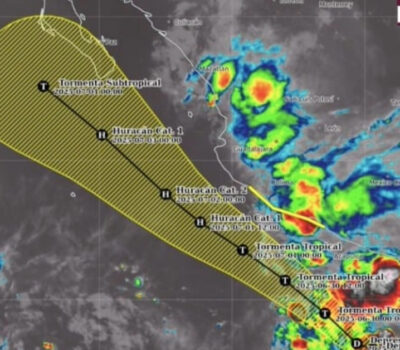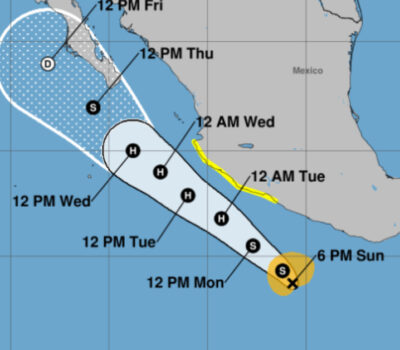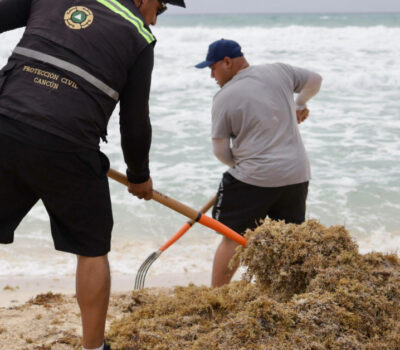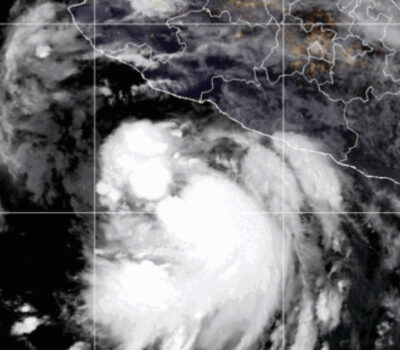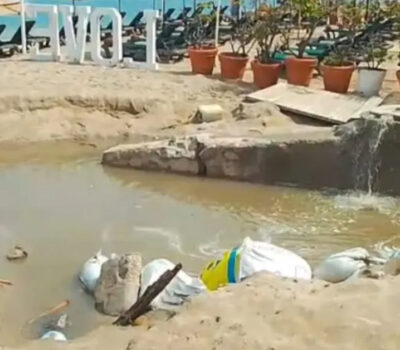People in the hamlet of Santa Ursula began to worry when the logging started. In a few short weeks, more than a mile of densely forested riverbank was stripped from the Arroyo Sal to make way for heavy dredging equipment.
Work was just beginning in late 2010 on an ambitious, three-year, $30 million project to build a 15-megawatt hydroelectric plant directly adjacent to the Cerro de Oro dam, with support from a U.S. government agency in Washington.
Next came dynamite explosions as crews blasted through rock to create a tunnel designed to feed power-generating turbines. In Santa Ursula, some 1.5 miles away, the ground shook and cracks formed in homes, some residents say. Finally, murky gray water began flowing from the taps, leading locals to fear the worst: contamination in the gurgling mountain spring that provides drinking water for nearly 2,000 people and feeds the arroyo.
“For us, the arroyo is life,” said Federico Cohetero, a farmer in Santa Ursula, a hamlet in Oaxaca state six hours southeast of Mexico City.
The project was financially supported by the Overseas Private Investment Corp, a U.S. government agency with a low profile but global mission. OPIC provided an $8.5 million loan guarantee for the hydropower retrofit in Mexico, part of its $60 million commitment to an investment fund focused on Latin American power projects.
On the ground in Mexico, the blasts and water worries triggered protests that put the project on hold. By late 2011, the protests resulted in a rare instance of a community fighting off development in a country where projects are often pushed through over local objections.
The fight also opened a window into the impacts that residents sometimes encounter in developments backed by OPIC. Its projects, intended to spur economic progress, have prompted protests in Liberia, Mexico and Chile, an Associated Press review found. Even as it approves $3 billion a year in global financing, the U.S. agency receives scant public attention or regulatory scrutiny. OPIC said its developments spur thousands of jobs and environmental upgrades, but the agency does not regularly disclose the status of its projects.
In Mexico, it took vocal community protests to bring the friction to light.
Gabino Vicente, a Santa Ursula town official who acts as a liaison with governments, showed AP journalists the area where the logging took place. It remains treeless, though tall grasses and shrubs point to a gradual recovery. Next to the arroyo, a gully-like channel carved out of the earth is strewn with boulders, an eyesore amid the lush green canopy.
“When they started cutting down the trees of the Arroyo Sal … That’s when we understood the magnitude of the damage they were beginning to do,” Vicente said.
OPIC and the project developer, New York’s Conduit Capital Partners LLC, defend the undertaking’s ambitions. The U.S. agency visited the site and retained experts to assess development impacts, and said the developer voluntarily suspended the project out of goodwill.
Conduit Capital Partners, which teamed with local companies in Mexico, calls the dam conversion an opportunity lost. “Unfortunately we had to write that project off,” said George Osorio, Conduit’s managing partner.
Osorio blamed the Accountability Counsel, a San Francisco legal organization representing residents, for helping kill the project. The executive accused the group’s members of “instigating the community to go against the project for the sole reason of justifying their existence.”
The Accountability Counsel said it helped residents push back against a development that affected them deeply. “Houses were cracking as a result of the explosion,” said executive director Natalie Bridgeman Fields, who visited Santa Ursula.
Fields said residents first contacted advocates, not the other way around, and that the environmental harm would have been much more severe had the project continued.
___
A painful history
For residents, the Cerro de Oro dam had a painful history even before work began in 2010. Ahead of the dam’s opening in 1989, 26,000 people were forced out, with many resettling in the coastal city of Veracruz.
Long-standing concerns fester about the dam. Many local residents are convinced the reservoir and the river below remain polluted from the villages swallowed up by the original dam construction, with vegetable material rotting in the lake’s floor. The water coming out of the original spillway is visibly murky and at times flecked with brown-orange foam.
Residents say dam maintenance has long been abandoned, with a single full-time employee operating the floodgates. On a recent visit it was overgrown with vegetation, with a rusty chain and a graffiti-covered sign: “Stop, passage prohibited — federal zone.”
The hydroelectric facility was to be built directly adjacent to the dam and reservoir. Developers planned to divert water through an intake tunnel, with water passing through turbines and being discharged into the Arroyo Sal, also known as La Sal Creek.
La Sal Creek had become a lifeline for the residents who stayed amid the initial dam construction or later moved there.
“It is something that is really part of the identity of the culture there,” said Mariana González Armijo, a researcher with Mexico City-based Fundar, Centro de Análisis e Investigación, a civil organization focused on public policy advocacy. “It is a creek that is used for fishing, for washing, for recreation.”
González, head of Fundar’s project on transparency and accountability in international financial institutions, said OPIC had an obligation to ensure the community was not harmed again: “Most of the people found out about the project when the explosions for dragging this creek started.”
The development was approved, records show, though contract paperwork forbade degradation of critical natural habitats. “Based on the information currently available, no indigenous people and cultural heritage sites near the project have been identified,” OPIC concluded. Yet advocates, in a formal complaint to OPIC, said indigenous people would indeed be impacted.
In October 2010, seven months after it consented to the project, OPIC strengthened its environmental and social policy guidelines. Spokesman Charles Stadtlander said the agency has increased communication with indigenous people, “including deeper historical and social consideration of a project’s local impact.” He said that “while indigenous populations lived in the area, they would not be directly affected by the project.”
Some residents say they’re still living with the consequences of the aborted hydroelectric plant.
Luz Maria Montor Hernandez, 69, is among those who have not yet repaired cracks in her walls she says appeared at the time of the dynamiting. “The ground was shaking,” she said.
In Santa Ursula, most people now buy bottled drinking water they can ill afford, with the nearest potable water source 5½ miles away. What comes out of the tap is full of silt similar to the sediment that’s steadily settling in the reservoir behind the dam, residents say.
“The water was nice and clean, sweet, crystal-clear before they did this,” Montor said. “It comes out dark and it smells bad. The water is not right, you know?”
Others are less concerned. Many people here fish in the reservoir and river, and restaurants openly serve locally caught mojarra fish. Even if the water is silty to drink, people say it’s still clean enough for bathing, irrigation and livestock.
Conduit Capital’s Osorio disputes the allegations of harm in a project that was part of a larger $392 million Latin Power III fund. Jobs and other benefits would have ensued, he said. “We become really good citizens in those local communities,” he said. “This is the first time this has happened to us.”
___
A project and protests
The protests formally began not long after the explosions. In November 2010, advocates filed a 40-page complaint to OPIC on behalf of residents from the towns of Paso Canoa and Santa Ursula in Tuxtepec, Oaxaca, Mexico.
The development violated OPIC policies on key fronts, the protest said: Project sponsors failed to fully disclose environmental and health impacts, did not consult with all affected residents before beginning construction and overstated the project benefits.
Another complaint was filed on behalf of the community of Los Reyes, situated closer to the construction site, though some residents there had signed pacts with developers agreeing not to seek assistance from outside organizations.
Project opponents say builders negotiated beforehand with landowners directly in the path of the spillway, leaving others in the dark.
“Everyone was wondering why they were cutting down the trees in the arroyo,” Cohetero said. When people asked for information, company representatives handed out leaflets that praised the hydroelectric plant, he said.
Ultimately, the town official, Vicente, said the communities concluded there would be minimal local economic benefit. Locals were offered temporary jobs during construction, lasting three years at most, and the electricity generated would be sent to industrial use in other states.
By February 2011, construction halted as the sides agreed to a study by a dam safety expert. Developers pitched an alternative plan to build a machine house further away from the Arroyo Sal, but agreement was not reached. OPIC’s Office of Accountability explored the conflict in Mexico, but ultimately decided against launching a full audit, issuing recommendations instead.
That November, representatives of Paso Canoa, Santa Ursula and Cerro de Oro formally rejected the original and alternative projects.
As Mexican President Enrique Pena Nieto pitches energy reform and encourages foreign investment, Vicente said he has pressed state officials about whether they intend to try again.
“Their answer was, ‘No, there is no intention of resuming this project, although we don’t rule it out.'” Vicente is not dead-set against the hydroelectric plan but said communities must be kept in the loop and environmental harm limited.
Adds farmer Cohetero: “We know that clean energy is important, but what sense is there in saying there is clean energy but in exchange we’re killing the arroyo?”
People in the hamlet of Santa Ursula began to worry when the logging started. In a few short weeks, more than a mile of densely . . .

